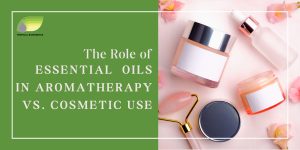
The Role of Essential Oils in Aromatherapy vs. Cosmetic Use
Understanding the science, purpose, and formulation differences.
Essential oils have been treasured for centuries, not only for their beautiful aromas but also for their versatile applications in wellness and skincare. As the global demand for natural products grows, essential oils are increasingly used in two key areas: aromatherapy and cosmetic formulations. While they share the same natural origin, their roles, benefits, and formulation requirements differ significantly.
In this article, we explore the unique functions of essential oils in aromatherapy versus cosmetic applications, offering insights into their distinct purposes and how they can be used effectively and safely in product development.
🌿 What Are Essential Oils?
Essential oils are concentrated plant extracts obtained through methods like steam distillation or cold pressing. They capture the volatile aromatic compounds of plants and possess a wide range of biological properties—antibacterial, anti-inflammatory, calming, energizing, and more.
Depending on the application, these oils can act as:
- Therapeutic agents in aromatherapy
- Active or fragrance ingredients in cosmetics
🌬️ Essential Oils in Aromatherapy
Aromatherapy is the therapeutic use of essential oils to promote physical, emotional, and mental well-being. It involves inhalation or topical application (with dilution) and is based on the idea that scent molecules interact with the limbic system in the brain, influencing mood and body functions.
✅ Key Roles in Aromatherapy:
- Emotional support: Lavender calms anxiety, while citrus oils uplift mood
- Stress and sleep aid: Frankincense and chamomile promote relaxation and restful sleep
- Respiratory support: Eucalyptus and peppermint open airways and relieve congestion
- Energy and focus: Rosemary and lemon boost concentration
💧 Application Methods:
- Diffusion: Dispersed into air through ultrasonic diffusers or sprays
- Inhalation: Directly from palms or inhaler sticks
- Topical (diluted): Massages, reflexology, and compresses
🧠 Science Behind It:
Aromatherapy relies on the psycho-emotional and physiological effects of essential oils. Their molecules can:
- Stimulate olfactory receptors
- Influence hormone levels
- Support the nervous and immune systems
💄 Essential Oils in Cosmetic Use
In cosmetic formulations, essential oils are used primarily for their skin benefits, antimicrobial properties, or natural fragrance. They must be chosen and dosed carefully to ensure they enhance the product without causing irritation.
✅ Key Roles in Cosmetics:
- Active ingredients:
- Tea Tree – antibacterial for acne care
- Geranium – balances oily skin
- Frankincense – promotes youthful-looking skin
- Fragrance compounds:
- Lavender, Citrus, Rose – provide natural scent profiles
- Preservation support:
- Some oils help extend shelf life due to their antimicrobial properties
🧴 Application Formats:
- Facial creams and serums
- Body oils and lotions
- Soaps and cleansers
- Lip balms and perfumes
🧪 Formulation Considerations:
- Concentration: Typically 0.5–2% depending on the product and oil
- Skin safety: Some oils can irritate sensitive skin or cause photosensitivity (e.g., citrus oils)
- Regulatory compliance: IFRA and local cosmetic laws must be followed
🔍 Aromatherapy vs. Cosmetic Use: Key Differences
| Aspect | Aromatherapy | Cosmetic Use |
|---|---|---|
| Primary Purpose | Emotional/therapeutic support | Skin care, beauty, fragrance |
| Application Method | Inhalation or diluted topical | Direct topical via products |
| Formulation Goal | Influence mood, promote wellness | Improve skin texture, tone, and appearance |
| Oil Selection | Based on emotional/physiological effect | Based on skin type, safety, and function |
| Dilution Rate | Often lower for inhalation; higher for massage | Regulated for skin safety (0.5–2%) |
| Stability Concern | Not as critical | Must ensure shelf life and stability |
🌺 The Synergy Between the Two
While distinct, aromatherapy and cosmetic applications of essential oils can complement each other beautifully. A calming lavender body lotion, for example, not only hydrates the skin but also soothes the senses. A peppermint foot balm can refresh tired feet and stimulate circulation.
At Tropical Bioessence, we specialize in helping brands craft multifunctional products that combine the best of both worlds—aromatherapy benefits with dermatological care.
🌱 Tropical Bioessence Essential Oils for Every Use
Whether you’re creating a wellness-driven aromatherapy line or a naturally inspired cosmetic product, we offer:
- 100% pure, tested essential oils
- Custom blends for aroma, function, or both
- Regulatory-compliant documentation
- OEM/ODM support for scalable production
✅ Conclusion: Purpose-Driven Selection is Key
Essential oils are incredibly versatile—but their application depends on the desired outcome. Are you looking to uplift the spirit, balance the mind, or nourish the skin? Understanding the difference between aromatherapy and cosmetic use empowers you to make smarter, safer, and more effective product choices.
→ Ready to formulate your next aromatherapy or cosmetic product with nature’s purest scents? [Contact Tropical Bioessence] for expert advice and development solutions.